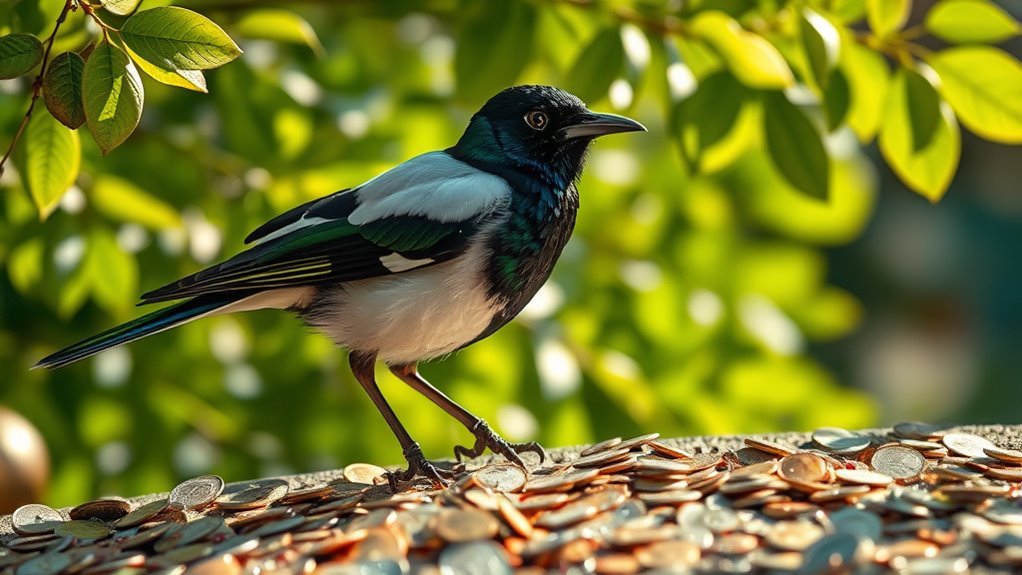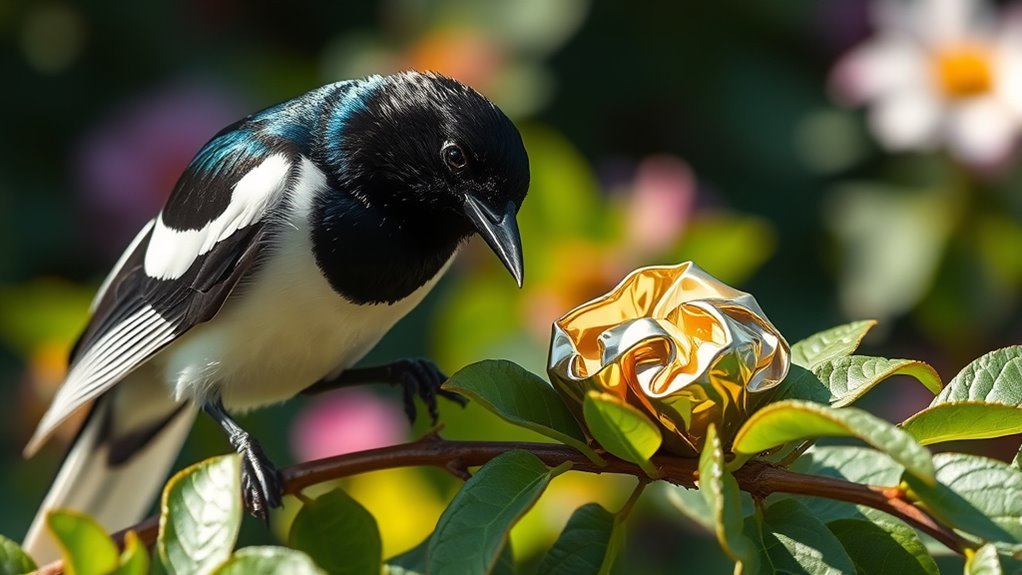Do Magpies Really Steal Shiny Objects?
Magpies are often seen as birds that take shiny objects, but their behavior is not as simple as it might appear. These birds show a strong curiosity which drives their interest in glittering items. Instead of stealing out of a desire to hoard, magpies may be exploring their environment. Their intelligence and social habits play a key role in this behavior. Understanding these aspects can change how you view magpies and their actions.
Key Takeaways
- Magpies are not specifically attracted to shiny objects; their curiosity drives them to investigate various items, including shiny ones.
- Misunderstandings about shiny object interactions stem from human interpretations, not actual theft behavior by magpies.
- Their exploration of shiny objects is motivated by intelligence rather than a desire to steal.
- Magpies exhibit social and intelligent behaviors, using complex communication to interact with each other and their environment.
- Recognizing their behaviors enhances our understanding, helping dispel myths surrounding magpies and fostering appreciation for these birds.
The Myth of Magpies and Shiny Objects

Many people think magpies are attracted to shiny objects. However, this belief isn't completely accurate.
Magpie stories often exaggerate this tendency, making their behavior seem more charming than it is. Magpies are curious and smart birds. They interact with shiny objects to explore and learn about their surroundings, not just to take things.
This behavior shows their problem-solving skills and social nature. Observing magpies teaches us about how we interpret nature.
Understanding Magpie Behavior
To understand magpie behavior, observe their actions and social interactions. Magpies are social birds that often form groups. In these groups, they communicate through various vocal sounds, showing their social structures.
Their nesting habits offer clear insights into their behavior. Magpies build large, intricate nests high in trees or shrubs, which they protect fiercely. The choice of nesting locations usually reflects their need for safety and community.
The Intelligence of Magpies

Magpies show great intelligence through their problem-solving skills. They can adapt to different environments and have excellent memory and learning abilities. You can watch their clever ways of finding food. They not only look for food but also learn from each other by watching and copying behaviors.
- They use complex communication to share details about food and dangers.
- They can remember where they hid food, showing advanced thinking skills.
- Magpies use tools. They manipulate objects to get food that's hard to reach, showing innovative problem-solving.
These abilities are fascinating and highlight their social intelligence among birds.
Curiosity: A Key Trait of Magpies
Magpies show curiosity in their behaviors, which is key to understanding them. These birds interact with their surroundings and often explore new objects with great interest.
Their playful nature is especially evident as they're drawn to shiny items. This attraction to shininess serves a real purpose, as they search for food or materials for their nests.
Observing this behavior highlights their intelligence, which goes beyond basic instincts. By paying attention to magpies, you can learn more about them and feel a stronger connection to nature.
Their energetic exploration helps you appreciate these birds and feel more connected to your ecosystem.
The Role of Visual Attraction

Magpies have eight distinct colors in their feathers. This variety enhances how they behave and interact with each other. Their keen eyesight allows them to spot shiny objects, which often grab their attention and spark their curiosity. These shiny items can bring magpies together, as they frequently gather around objects that catch their eye.
- They communicate better through colorful displays.
- Shiny items can show social status among magpies.
- They build friendships based on common interests.
Observing how magpies react to shiny things shows their intelligence and ability to adapt in different settings. This fascination reveals how they interact with their environment and each other, making it easier to appreciate their unique behaviors.
What's Considered "Shiny"?
Shiny objects attract magpies due to their reflective surfaces.
These objects can include materials like metal, glass, and some plastics. Their shine and the way they reflect light draw the attention of these birds.
This attraction likely comes from evolutionary traits, where shiny objects may suggest potential value or novelty.
Understanding what magpies find shiny provides insight into their behavior.
Next time you see a glimmering object, think about how it captures the interest of a curious magpie.
Magpies in Their Natural Habitat
Magpies thrive in various habitats, including cities, open fields, and woodlands. They're adaptable birds that build distinct nests in trees or shrubs. You can find them in many places, showcasing their ability to live in different environments.
- They like areas with lots of vegetation for shelter and food.
- In urban environments, they often eat human food, which helps them adapt even more.
- Magpies frequently return to the same nesting locations year after year, showing strong loyalty to their sites.
Knowing these traits of magpies can help you appreciate their natural behaviors and the many environments in which they live.
Human Interaction With Magpies
Magpies in urban areas show curiosity and opportunism toward humans. These smart birds learn that people can provide food. You may see magpies near picnic spots looking for scraps or sitting close to people hoping for a treat. This behavior highlights their cleverness and adaptability.
As you watch these birds interact, you might feel a connection while enjoying their playful actions. Learning about their habits can help you appreciate magpies more, creating a mutual respect between you and these birds.
This connection can enhance your experience in shared spaces, bringing together humans and magpies.
The Influence of Environment
The environment significantly shapes magpies' behavior and lifestyle. Understanding how environmental factors influence them highlights their adaptability across different ecosystems. Magpies live in various habitats, affecting their foraging techniques, social groups, and interactions.
- Habitat diversity: Different environments provide distinct food sources and materials that influence magpie behavior.
- Urban vs. rural settings: Magpies adjust to city living and human proximity, showing more boldness and creativity.
- Seasonal changes: Changes in weather and seasons influence their nesting habits and social behaviors.
This knowledge helps us appreciate the resilience of magpies in adapting to their surroundings.
Scientific Studies on Magpie Behavior
Many scientific studies have examined magpie behavior, revealing important details about their intelligence and social structures. Research shows that magpies are capable of recognizing themselves in mirrors, which indicates a level of self-awareness uncommon in animals.
Other studies focus on how magpies interact within their groups, showing that they've complex social networks and strong communication skills. These observations demonstrate their problem-solving abilities, such as using tools to access food.
Magpies also display behaviors that suggest they can deceive others, further highlighting their intelligence. Studying magpie behavior offers insights into animal cognition and social interaction, making them a fascinating subject for both researchers and nature enthusiasts.
Cultural Significance of Magpies
Magpies hold significant meaning across various cultures due to their unique appearance and interesting behaviors. These birds often symbolize different aspects of human beliefs and values. Their roles in folklore can bring about feelings of joy, luck, or foreboding.
In Chinese culture, seeing a magpie represents happiness and good news.
In European folklore, magpies are often seen as thieves, symbolizing curiosity and trickery.
Indigenous tribes view magpies as spiritual messengers that connect the physical and spiritual worlds.
These varied interpretations highlight the importance of magpies in cultural narratives, making them a compelling subject for further exploration.
Tips for Bird Watchers
Bird watching is a rewarding activity that requires some planning and patience. Here are some simple tips to improve your experience.
First, buy a good pair of binoculars. They help you see birds clearly from a distance. Learn about the birds in your area by checking field guides or birdwatching apps.
Early mornings are the best times to watch birds since they're most active then. Be quiet and move slowly. This approach helps you avoid startling them. Pay attention to their behaviors. Notice how they feed, their calls, and how they interact with each other.
Consider joining local birdwatching groups. They can provide valuable insights and connect you with other bird lovers.
Every moment you spend observing birds builds your knowledge and appreciation for them. Enjoy your birdwatching journey!
Debunking Common Misconceptions
Many people admire magpies for their striking looks, but they often misunderstand their behavior and intelligence. It's important to correct these myths to appreciate these birds better.
Here are some common misconceptions about magpie behavior:
- Shiny Object Theft: Magpies don't intentionally look for shiny items. Their curiosity leads them to explore different objects.
- Aggressiveness: While magpies will defend their nests, they're generally social and smart. They aren't naturally aggressive.
- Intelligence Limitations: Magpies show advanced problem-solving skills. They can recognize themselves in mirrors, highlighting their intelligence compared to many other birds.
Understanding these facts helps us appreciate magpies for the fascinating creatures they are.
Frequently Asked Questions
Do Magpies Prefer Specific Colors Over Shiny Items?
Magpies display clear color preferences. They are often attracted to bright colors and shiny objects. Watching how they interact with these items can provide interesting information about their preferences. Their curious nature makes them fascinating to observe in their habitat.
Can Magpies Recognize Individual Humans?
Yes, magpies can recognize individual humans. They have the ability to tell familiar faces apart from unfamiliar ones. This skill reflects their intelligence and shows how they interact with us. Like humans, magpies form social connections based on their interactions. This recognition helps them navigate their environment and respond to different people appropriately.
What Is the Lifespan of a Magpie?
The average lifespan of a magpie in the wild is 3 to 5 years. However, some magpies can live for over ten years. These birds adapt well to their surroundings, which helps them survive and live longer in different environments.
Do Magpies Have Any Natural Predators?
Magpies have natural predators such as hawks and foxes. When nesting, magpies protect their young fiercely. This behavior shows their strength and ability to face dangers in their habitat.
Are Magpies Social Birds or Solitary?
Magpies are social birds. They form strong groups and work together in their daily activities. You can often see them foraging in pairs or larger groups. This teamwork helps them find food more easily and strengthens their relationships with each other. Their social nature makes them adaptable and successful in various environments.

Hello, I’m Emily Price, the founder of Birds Affection. As a passionate bird enthusiast and spiritual seeker, I’ve always been fascinated by the symbolic meanings and mystical connections between birds and our lives. On this website, I share my knowledge and insights on the spiritual significance of various bird species, exploring their roles as messengers, guides, and teachers. Through my writing, I aim to inspire and educate others on the profound wisdom and beauty that birds bring to our world. Join me on this journey as we delve into the enchanting realm of bird symbolism and discover the hidden meanings behind these magnificent creatures.







